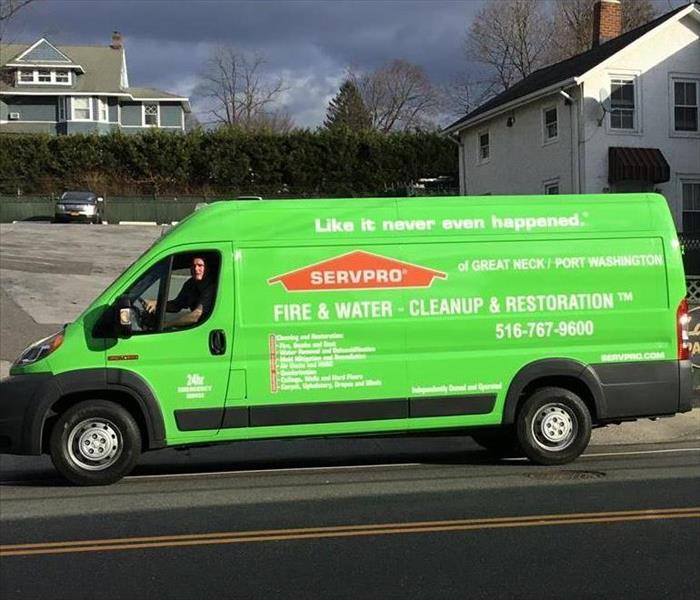How Do I Remove Water from My Basement Floor?
4/21/2020 (Permalink)
SERVPRO Has Powerful Extractors, Drying Tools, and Reconstruction Techniques to Dry Your Great Neck Basement and Prevent Future Flooding.
Basements can be a hotspot for water damage and groundwater infiltration, so addressing standing water or penetrating moisture should be a priority for homeowners living in Great Neck. Permanent solutions are critical in these situations, or this destructive situation has an opening to occur again and again.
Cleaning up after flooding or basement water removal for Great Neck homes hinges on the fast response of our qualified technicians. Because we are ready to help in these emergencies 24/7, we can reach most loss incidents within hours of the first notice of loss. Because you are speaking to a real person and not a recording when you call the emergency line, we can begin compiling essential details about your disaster quickly, so we have the right tools and personnel en route.
What Mitigation Steps Must Happen Right After Flooding?
Mitigation is vital for your home and its contents because this phase is exclusively designed to reduce losses for the property. From the moment that our team first arrives at your house, we have to get specific tasks started quickly to ensure that we can slow the migration of flooding effects and begin the essential extraction of the flooded basement level. These fundamental processes include:
Water Removal
• Extraction is one of the critical elements of flood recovery and must occur before almost any other mitigation step. To access areas for cleaning or even controlled demolition, standing water must get entirely removed. This process occurs through the use of powerful extraction tools like our submersible pumps and wet vacuums.
Muck-Out
• Cleaning out debris, mud, and other solids that can come in with heavier flooding from the outside is also a vital component to protecting your property. Shoveling out the muck from a natural flooding situation can reduce the possibility of bacterial threats and other contaminants, not to mention, prevent exposed contents from becoming irreparably damaged.
Controlled Demolition
• Many flooding scenarios require controlled demolition. Removing overly compromised portions of structural elements prevents collapse and worse conditions later on. Our SERVPRO contractors can focus on what areas need removal based on a thorough inspection. Early controlled demolition can help to reduce widespread reconstruction later.
How Can SERVPRO Dry My Flooded Basement?
Drying out the lower level of your home is a situation that requires our professionals to utilize cutting edge equipment and staples of drying sciences. By finding the ideal balance of humidity, temperature, and airflow, we can maximize evaporation and restoration in damp and moist areas like the basement of your flooded home. Some of the key tools and devices for drying out floodwater are:
How About Evaporation Equipment?
• While often compared with fans, these units have a more direct and beneficial purpose in the drying of your home. Centrifugal air movers, for example, target-specific portions of water-damaged structural elements and contents to protect them from requiring replacement or discarding.
• Dehumidifiers
• Because regulating the relative humidity in the house is a vital element in the drying science balance required to overcome flooding threats in a basement; we set desiccants and low-grain refrigerant (LGR) units throughout the property to keep up with the evaporative effects of properly positioned air movers.
• Portable Electric Heaters
• Electric heaters that we bring to job sites are multi-purpose. Their immediate use can regulate an elevated temperature to increase evaporation rates of damaged structural components and the environment. We can also utilize these portable heaters to warm structures when flooding disrupts available power.
Is Contamination a Threat After Natural Flooding?
Natural flooding is a situation that is always assumed to introduce contaminants to your home. Because our technicians cannot account for the path of the water reaching your home, it must then get assumed that it has come into contact with potential bacteria, viral pathogens, and chemicals. We treat natural flooding in the same way we do sewage backups with our biohazard cleaning team.
What Are Long-Term Solutions to Prevent Flooding?
Cleaning and drying up flood damage in your basement is critical, but it is only a final step when the valid provisions have gotten taken to prevent recurrences from moving forward. Long-term construction solutions and repairs can entirely prevent the penetration of floodwater so that your basement can stay dry and usable after the restoration completes. By installing new equipment or repairing a damaged block wall, we can reduce moisture penetration and prevent a recurrence of flooding. Some of the most common techniques include:
• Hydraulic Cement
• Masonry Repair
• Permanent Dehumidifier
When you discover floodwater in your basement, it is a situation that you want to address as soon as you can. We strive to provide fast and efficient service from extraction to drying and repairs. Give our SERVPRO of Great Neck / Port Washington team a call today at (516) 767-9600.




 24/7 Emergency Service
24/7 Emergency Service
